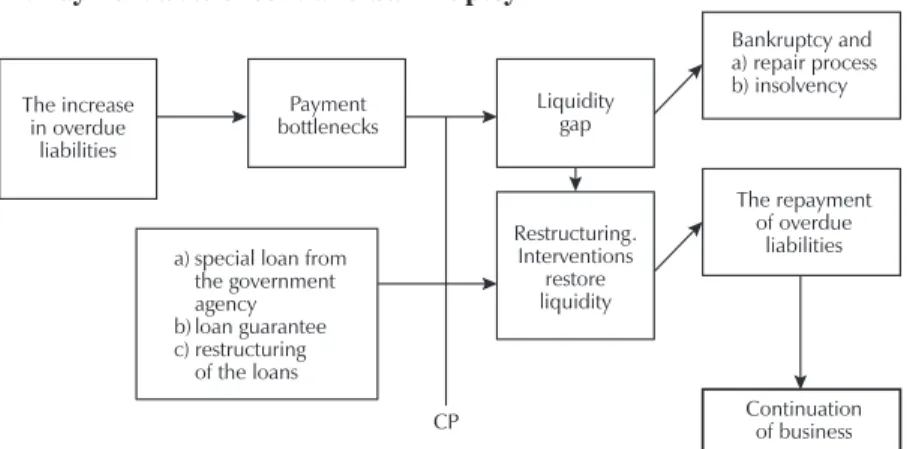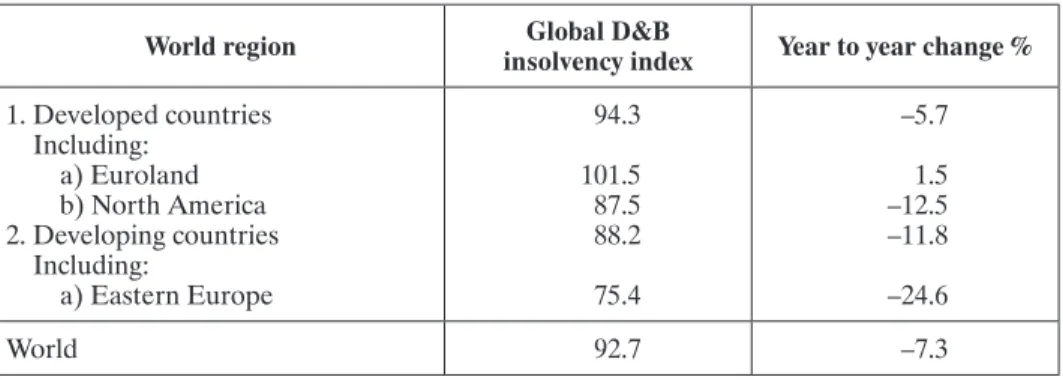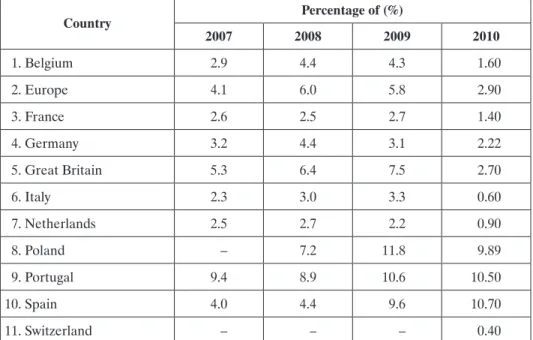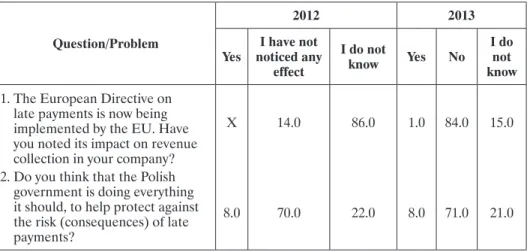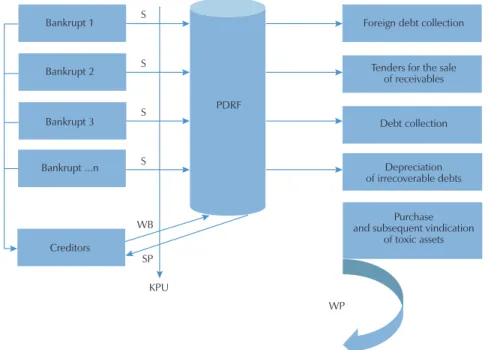IN
THE
E
UROPEAN
U
NION
AND
IN
P
OLAND
Piotr Masiukiewicz
*, Paweł Dec
**Abstract
The authors have attempted to develop new instruments deactivation payment bottlenecks, the scale of which in recent years has significantly increased in the European Union. The article described synthetically theoretical aspects of debt companies. It was also presented a mathematical formula of the liquidity as a function of the cash flow. Additionally, the authors conducted a quantitative analysis of the problem payment bottlenecks, debt and insolvency in the European Union and Poland. Characterized also regulations on the issue of late payments in companies. Both authorities at European Union and national take certain steps to regulate the legal problems concerning payments to contractors, including mainly need the delayed payments and late payments. An important part of the article relates to proposals for the development of instruments deactivation the payment bottlenecks. Moreover the authors present a detailed concept of the fund bad debts. Such a fund would function as quasi-fiscal institution equipped with the capital of the Treasury or entity acting on the basis of public-private partnership.
JEL classification: G32, G33, G 34
Keywords: payment bottleneck, bankruptcy, debt
* Prof. ndzw. dr hab. Piotr Masiukiewicz – Instytut Zarządzania Wartością, Szkoła Główna
Handlowa.
** Dr Paweł Dec – Instytut Finansów Korporacji i Inwestycji, Szkoła Główna Handlowa;
1. Introduction
The liquidity management in enterprises is one of the most important tasks in running a business. Improper management of liquidity not only the loss of potential revenue, but mainly increases the risk of insolvency of the entity, which in turn may lead to the bankruptcy of the company. The economic downturn of recent years, the decline in production, orders and often dishonesty contractors, all intensified the problem of the occurrence and growth payment bottlenecks in Poland and Europe. Their negative impact on the functioning of many companies, both in and out of the small and medium-sized enterprises and large public companies is so great consequences for the entire economy, that this issue still requires finding the appropriate regulations in this area. Furthermore, the increase payment bottlenecks significantly increases the risk of bankruptcy of enterprises.
The purpose of this article is to propose new instruments deactivation payment bottlenecks in the context of the scale of the problem, including the possibility of its imports from the European Union.
2. Theoretical aspects of debt companies
The problem of the structure and sources of funding and debt management companies is fairly widely described in the literature especially in the field of finance (Duliniec, 2011; Grzywacz, 2013). In contrast, the problem of payment bottlenecks and instruments of their deactivation is not given so far wider published and research. In the Polish study this issue dealt with K. Kreczmańska-Gigol (2010). The problem of risk and liquidity management in enterprises is the subject of research by many authors (Michalski, 2005; Sierpińska, Jachna, 2011; Duliniec, 2011; Saleem, Rehman, 2011; Castagna, Fede, 2013). April 28, 2013 came into force the Act of 8 March 2013 on payment periods in commercial transactions, whose main objective is to reduce traffic late payments in Poland. Payment bottlenecks in the economy can be described as the lack of current liquidity to a large number of enterprises causing significant delays in settling claims by these companies (Faulhaber, Landwehr, 2005). A company’s liquidity depends on a few basic factors and has to always be analysed according to the temporal criteria. Underestimation of the time factor is the primary cause of payment gridlocks in the economies (Blatz et al., 2006). Liquidity is a function of cash flows, which can be expressed in the form of the following relationship:
Pc = j : [–SNt xr1 + WSt xr2 + DFxr3 + RGt x(
±
)LF – KNt ] Where:Pc – liquidity level,
SN – payment of liabilities in due time,
WS – timely receipts from sales and other receivables, DF – available short-term financial leverage,
RG – cash reserves, LF – financing gap ratio, KN – extraordinary costs, r – risk factor,
t – period of time.
Figure 1. Payment bottlenecks and bankruptcy
The increase in overdue liabilities Payment bottlenecks Liquidity gap Restructuring. Interventions restore liquidity CP a) special loan from
the government agency b) loan guarantee c) restructuring of the loans Bankruptcy and a) repair process b) insolvency The repayment of overdue liabilities Continuation of business
Legend: CP – a critical point; possible request of creditors of the insolvency. Source: own work.
Few research indicates that in Poland there are several causes that are important for inducing the phenomenon payment bottlenecks. Research concerning risks in normal and crisis environments carried out by Deloitte in 2009 on the sample of 251 companies demonstrated that in 21% cases companies perceived the risk of a limited credit activity as a significant obstacle in doing business, and almost 36% pointed to the risk of payment gridlocks, a problem that can be connected to a loss of sources of financing (Lewiatan, 2009). The causes of delays in payment vary. Constant researches in this area are being carried out by Intrum Justica, an international research and consultancy firm. Table 1 illustrates the causes of payment delays in Poland, as suggested by Intrum Justica research.
Table 1. The causes of payment delays in Poland as suggested by the research (%)
Type of a cause/year 2012 2013
1. Deliberate action 2. Contentious situations 3. Inefficient administration 4. Debtors’ financial problems
61.0 30.0 42.0 88.0 68.0 24.0 43.0 90.0 Source: a study of 800 Polish companies (PARP, 2013).
Table 2. The relation of debt governed by public law to debt governed by civil laws in the examined cases of companies’ failures over 2004–2010
Examined bankruptcies case
files in a district court of examined casesNumer Debt governed by public law Debt governed by civil law
1. SR Wrocław-Fabryczna 2. SR m. st. Warszawa 3. SR Kraków Śródmieście 4. SR Białystok 98 250 144 21 20.0 35.0 17.0 60.0 80.0 65.0 83.0 40.0 Source: own work based on S. Morawska (2013, p. 159).
A research by S. Morawska on the structure of failed companies’ debt demonstrated a very worrying situation (Morawska, 2013). Debt governed by public law (from state institutions) amounted, depending on the region, from 20% to 60% in the structure of total debt for the groups of companies that have been investigated (Table 2). It is a very worrying situation, when state institutions do not settle their liabilities on time, as this contributes to business bankruptcies. One cannot underestimate the threat of import payment bottlenecks from some European Union countries.
3. The problem of payment botllenecks
in the European Union
Late payments in commercial transactions became a problem in many European Union member states, including Poland. They result in companies’ short- or long-term loss of liquidity, macro-scale payment gridlocks, distortion in the conditions of competition, increase in cash payments and even in business bankruptcies (Dun & Bradster, 2011; Borowski et al., 2013).
We are witnessing thousands of unnecessary bankruptcies in the EU, if we do not respond, it will be even worse – alarmed in 2009, Bruno Vanryb,
chairman MiddleNext – an association of French medium-sized businesses. Over 150 thousand European companies in 2008 lost liquidity. There was four times more than in the U.S. In a bad situation there are many European banks, which refuse to restructuring loans to entrepreneurs. Every fourth insolvency by the EU Commission is due to not paying their bills by customers. The EU has recommended the introduction of regulations to facilitate debt collection companies – but does it solve the problem?
Table 3. Global D&B insolvency index 2011 (Q II)
World region insolvency indexGlobal D&B Year to year change %
1. Developed countries Including: a) Euroland b) North America 2. Developing countries Including: a) Eastern Europe 94.3 101.5 87.5 88.2 75.4 –5.7 1.5 –12.5 –11.8 –24.6 World 92.7 –7.3
Source: Dun & Bradster (2011, p. 2).
Global insolvency in the economy index published by Dun & Bradster has reach its peak value in Euroland members and showed an increasing trend in that regard. It is a truly disturbing situation (Table 3).
Poland was, until recently, at the forefront of the EU in terms of payment delays. The average length of settling payments in transactions with public authorities amounts to 65 days, and in commercial transactions with enterprises to 52 days. In Poland, the average length of settling payments in transactions with public authorities amounts to 39 days and 52 between entrepreneurs. SMEs sector is more vulnerable to the consequences of liquidity difficulties, and administrative costs (including court costs) related to debt recovery are disproportionately high for these companies.
Potential consequences of payment gridlocks may include:
• 35% of companies having difficulties in recovering debt do not meet obligations toward their contractors,
• 35% of companies limit their investments,
• 12% of companies cut employment or limit wages,
• 7% of companies increase prices on their products, thus moving the liquidity costs on their clients.
The loss of confidence in state authorities may be another result (Masiukiewicz, 2012). However, the most dangerous consequence is the emergence of a threat associated with the growth of illegal lenders to entrepreneurs (Masiukiewicz, 2011). A. Tajani, the European Commissioner for Enterprise and Industry has said: Every year thousands of SMEs go
bankrupt waiting for their invoices to be paid. We are committed to ending the damaging culture of late payment in Europe, which has long been an issue of concern in the business world. It is clearly urgent for Member States to implement the Late Payments Directive into their national law as early as possible (European Commission, 2012).
Table 4. The percentage of late payments more than 90 days in some European countries in 2007–2010
Country Percentage of (%) 2007 2008 2009 2010 1. Belgium 2.9 4.4 4.3 1.60 2. Europe 4.1 6.0 5.8 2.90 3. France 2.6 2.5 2.7 1.40 4. Germany 3.2 4.4 3.1 2.22 5. Great Britain 5.3 6.4 7.5 2.70 6. Italy 2.3 3.0 3.3 0.60 7. Netherlands 2.5 2.7 2.2 0.90 8. Poland – 7.2 11.8 9.89 9. Portugal 9.4 8.9 10.6 10.50 10. Spain 4.0 4.4 9.6 10.70 11. Switzerland – – – 0.40
Source: own work based on CRIBIS D&B (2011).
In the European Union late payments over 90 days, most are – Spain, Portugal and Poland, where the rate is increasing over the years 2007–2010. In the countries such as Belgium, France, Holland, Italy indicator such overdue receivables falls to levels below 2% and 1% (Table 4).
4. New regulations
The basic legal and advisory instruments established by the European Union are defined in the following communications and legislation:
a) Communication from the Commission to the Council, the European Parliament, the European Economic and Social Committee and the Committee of the Regions: Overcoming the stigma of business failure – for a second chance policy, Brussels, 2007;
b) Community guidelines on State aid for rescuing and restructuring firms in difficulty Brussels, 2004;
c) Directive 2011/7/EU of the European Parliament and of the Council of 16 February 2011 on combating late payment in commercial transactions, Brussels, 2011.
The European Commission has implemented a new directive concerning the payments in commercial transactions that lead to delivery of goods or services with a remuneration for goods or services provided (Directive nr 2011/7/EU). In particular, this regulation covers the following subjects: • Transactions between entrepreneurs, including main contractors and their
suppliers and subcontractors,
• Transactions between entrepreneurs and public entities (institutions). The Directive defines minimum standards that the EU and EFTA member states are obliged to implement in their home legislation. Significant regulations introduced by the directive include:
• a creditor is entitled to interest for late payment without having to remind, • a procedure of acceptance or verification must be provided in the contract
(or in an act),
• payment period specified in a contract between entrepreneurs cannot exceed 60 days (unless otherwise specified in the contract and it is not grossly unfair to the creditor), and in transactions with state institutions it cannot exceed 30 day (however, with regards to certain institutions such as healthcare provision the member states may exceed the payment period up to 60 days). Nonetheless, it only concerns state institutions and not state-owned enterprises,
• if the period of payment is not specified in a contract, the interest is charged after 30 days from the date of receipt of the invoice (if the date is not certain, it is 30 days from receipt of goods or services),
• interest rate for delay in payment can be agreed in a contract (unless it is not grossly unfair to the creditor),
• the minimum interest rate on late payment equals the reference rate (the ECB or a national central bank) plus 8%,
• minimum compensation for costs of recovery, unless otherwise specified in a commercial contract, is set at 40 Euro; it should be paid without the need to remind (converted into PLN according to NBP average exchange rate),
• provisions extending period of payment beyond 30 days in case of transactions with state institutions, excluding interest for late payments or excluding compensation for costs of recovery with either entrepreneurs or public authorities are recognized as grossly unfair,
• an enforceable title should be obtained, in principle, within 90 calendar days after filing a lawsuit to the court.
Member states were encouraged to create codes of prompt payments and to publish interest rates for late payments. Poland has implemented the principles of this Directive in the Act of 8.03.13. This law is a lex specialis to the provisions of the Civil Code applies to contracts which have been concluded after its entry into force. Available to creditors are also legal instruments such as the European Enforcement Order and the European enforcement proceedings.
A study conducted by Intrum Justitia in 2013 indicated a very low level of knowledge in Polish companies about the new regulations on payments in the economy. Only 16% of the investigated companies were up-to-date with the new regulations (Table 5). There is therefore a need for government agencies to implement the programmes popularizing the new rules and to initiate training in this field.
Since many years initiatives to improve the timeliness of payments are being launched in Poland. These, among others, include (PARP, 2013): • SOLVIT system – a free problem solving network created by the
European Commission, under which the EU plus Norway, Iceland and Lichtenstein attempt to find a practical solution to a problem raised by the entrepreneur within 10 weeks. SOLVIT Centre Poland operates in Poland,
• databases of overdue debtors are conducted (KRD BIG SA, the Polish Bank Association, et al.),
• titles and diplomas „Trustworthy Company” awarded, inter alia, by BIG SA,
• infopozytywni.pl portal – run by ERIF, recommending a list of good debtors.
Regulatory initiatives and social initiatives should have a significant impact on reducing payment bottlenecks. It should also be hoped that the level of ethics of debt repayment will increase also in Poland, and that unreliable companies will increasingly lose market share in the Polish and European markets (Bekas, 2010).
Table 5. Evaluation of the impact of the new EU directive on payments and in the light of research (%)
Question/Problem
2012 2013 Yes noticed any I have not
effect I do not know Yes No I do not know
1. The European Directive on late payments is now being implemented by the EU. Have you noted its impact on revenue collection in your company? 2. Do you think that the Polish
government is doing everything it should, to help protect against the risk (consequences) of late payments? X 8.0 14.0 70.0 86.0 22.0 1.0 8.0 84.0 71.0 15.0 21.0 Source: PARP (2013).
5. Instruments deactivation payment bottlenecks
5.1. Available instruments
A company’s intervention measures resulting from losing liquidity may concern the following sources of financing: renegotiation payment periods, application for a liquidity credit, wider use of bills of exchange, application for a loan for the survival from a state agency, sale of debt to a factoring or forfaiting company, leaseback transactions and the use of cash pooling (Polak, 2008). Measures requiring a longer period of time include the sale of unnecessary fixed assets, raising equity and a reduction in activity and employment. Banks can fulfill an important remedial function. It is in banks’ interest that companies and farmers, who are their clients, maintain their financial liquidity. If not, the risk for a bank rises(Iwańczuk, 2011; Masiukiewicz, 2011). A new tool – short-term liquidity loan – was introduced in Poland in 2013 to help entrepreneurs uphold their liquidity and thus
reduce payment gridlocks in economy. The loan is granted by banks. It is insured by the treasury of Poland and the guarantee is granted by Bank Gospodarstwa Krajowego on the behalf of the Finance Minister. A guarantee is granted free of charge for periods no longer than 1 year. Short-term liquidity loan is the long-postulated financial leverage for companies losing liquidity (Masiukiewicz, Nowak, 2012).
5.2. The proposal to create a fund of bad debts
The search for measures to improve the efficiency of temporal bankruptcy process can go in different directions. It is possible to try to design a system of motivation syndics, which would provide such efficiency. This would imply, however, the costs of premiums and prizes on the one hand and, on the other hand, does not increase the trustees instruments in the area of recovery. You can try to determine the maximum duration of the process, depending on the size of the company, however, does not solve the problem of residual debts. Barriers are outside the company, hence the need to seek solutions to the legal and economic environment (Masiukiewicz, Nowak, 2011). It should be paid attention to several issues. First, the recovery process requires specialized personnel and the legal and economic skills in business intelligence (sometimes internationally) (Ciecierski, 2009). Secondly, at low ethics repaying debts in our country, the authority and power of the judicial trustee against debtors is often insufficient. Thirdly, there are situations in the economy in which the debtor bankrupt company after a while recovers liquidity and may ask receivable (payment delays, the domino effect, and others).
The question arises why the recovery of debts in the process of bankruptcy is a barrier operation and effectiveness of the whole process? The reasons are many, are presented below some of the most important:
• Lack of motivation syndics to quickly end the bankruptcy proceedings – hence the possible extension of the recovery process;
• Difficult to recover debts cases (e.g. lack of security for the repayment) and lengthening lawsuits against debtors bankrupt;
• Difficulties and legal barriers to a quick sale of assets, the lack of a deve-loped market for used assets;
• Lack of funds for market valuation of assets held for sale;
• Lack of adequate authority of syndics to cause unethical conduct of the bankrupt debtors in terms of payment;
• Where debts recovered by the bankrupt – gradually consuming them as a result of the costs (i.e. no financial effect for the creditors of the bankrupt).
Another problem to be solved is the residual claims of liquidated companies, which are not declared bankrupt due to lack of funds. The author's proposal to solve the above problems includes the creation of a state agency – the Public Debt Restructuring Fund (PFRD) supervised by the Ministry of Justice.
The purpose of the fund would be:
• Transfers of debts so called residual of insolvent companies (both by track bankruptcy and liquidation without declaring bankruptcy) – at the request of the Commissioner of the bankruptcy judge;
• Taking over all foreign debts of insolvent companies (both by track ban-kruptcy and liquidation without declaring banban-kruptcy and a limited range of enterprises implementing corrective actions) – at the request of the Commissioner of the bankruptcy judge;
• Issuance of debts for sale;
• Conducting a professional debt collection in the country and internatio-nally;
• Cancellation of uncollectible debts;
• Purchase of bad (toxic) assets and their subsequent recovery.
Along with taking over debts have cared fund liabilities to creditors of the bankrupt and satisfy them with the assets recovered by the fund from a particular company in bankruptcy – until their total lack. Costs of debt collection would be included in the weight of recovered debts. At the request of the judge-commissioner (or the Financial Supervision Authority) supervising the repair process of a company, the fund could also justified cases, to buy up toxic assets – hindering the process of recovery (Masiukiewicz, Nowak, 2011). The fund also would specialize in the recovery of claims of foreign owned fallen and implementing the recovery program businesses, and the target also overdue foreign debts of the central and regional offices. The revenues of the fund will be the bank interest on deposits of capital and receivables that were recovered by debt collection (periodically), as well as donations or grants.
The outline of the concept of public debt restructuring fund illustrates Figure 2. The fund could be of a quasi-fiscal institutions equipped with a capital of the Treasury or the contracting public-private partnership.
The idea of the fund or the bank’s bad debts (toxic assets) is not new. Such solutions have appeared in times of financial crisis in many countries around the world. Among other things, as a result of the financial crisis in Finland in 1991, bad loans (in case of lost) and other bad assets Skopbanku transferred to a specially appointed at the initiative of the government
companies: Sponda, Scopulus and Solidium (Iwanicz-Drozdowska (ed.), 2002). During the crisis in Sweden in 1992 separated the toxic assets (debts of banks) to special companies bad debts; Enskilda Banken of Skandinávská Diligentia to the company, and the company Handelsbanken Nackebro.
Figure 2. The concept of public fund debt restructuring
Bankrupt 1 Bankrupt 2 Bankrupt 3 Bankrupt ...n Creditors WP WB SP S S S S KPU
Foreign debt collection
Tenders for the sale of receivables Debt collection Depreciation of irrecoverable debts PDRF Purchase and subsequent vindication
of toxic assets
Legend:
PDRF – Public debt restructuring fund,
S – sale / transfer (assignment by the judge-commissioner) of late residual debts (claims of the bankrupt) according to the current valuation,
WB – transfer of rights of the creditor of the bankrupt to the claim (liability of the ban-krupt) to PDRF,
SP – repayment of liabilities of the bankrupt, KPU – the end point of bankruptcy,
WP – revenues PDRF. Source: own work.
In the recent financial crisis were the subprime toxic assets from banks prosumers by central banks or special banks’ bad debts. As part of the repair process in the United States divided between the other GM’s bankruptcy as a result of a healthy company and the company with the toxic assets held for
debt collection and, ultimately, the company goes out of business bankruptcy (Masiukiewicz, Nowak, 2012).
Establishment of debt restructuring fund will give a number of advantages, namely:
a) economic benefits is to reduce the operating costs of trustee’s office, the possibility of better and more efficient recovery by a specialized institu-tion, shortening the bankruptcy process, reduce waste, and increase the level of satisfaction of creditors of the bankrupt;
b) intangible benefits means the reduction of demoralization not paying debts bankrupt companies, reducing social criticism on the administration of justice, moral satisfaction of creditors, strengthen social belief in the law and others.
The implementation of the proposed management model overdue debts within the repair process or the process of corporate bankruptcy is a matter of the Ministry of Justice.
6. Conclusions
The problem of the payment bottlenecks occur periodically in many countries. In recent years, the European Union is inglorious first place among the regions of the world at a high level of bottlenecks. Proper management of financial liquidity within the enterprise, including the selection of appropriate methods of controlling the time of repayment of debts, must be properly implemented in companies. Of course, they do not provide full protection against the loss of liquidity and a possible bankruptcy. Nevertheless, the same use of such tools can reduce the risk of business. The share of public institutions in creating payment gridlocks warrants greater involvement of governments in the deactivation of these bottlenecks. Particularly important is the access of companies to short-term financial leverage, enabling timely payments – such a mechanism with the participation of government guarantees was introduced in Poland. Of course the development of debt, including overdue debt, market – also on the international scale – is necessary as well. No response to these problems may lead to the development of a loan black market. It is also important to educate entrepreneurs in this area. It should be hoped that the actions taken by the European Commission will bring the desired results.
References
Bekas, M. (2010). Etyka regulowania należności przez przedsiębiorców i konsumen-tów. Prakseologia, No. 150.
Blatz, M., Kraus, K.J., Haghani, S. (eds). (2006). Corporate Restructuring: Finance in
Times of Crisis Roland Berger Strategy Consultants, Berlin.
Borowski, J., Czerniak, A., Kapuściński, M. (2013). Rosną zatory płatnicze, ucierpią
zatrudnienie i inwestycje, Retrieved: www.obserwatorfinansowy.pl
Castagna, A., Fede, F. (2013). Measuring and Managing Liquidity Risk. West Susex: Wiley.
Ciecierski, M. (2009). Wywiad międzynarodowy w korporacjach transnarodowych.
Teo-ria i praktyka. Toruń: Wydawnictwo Adam Marszałek.
CRIBIS D&B. (2011). Payment Practices Study.
Duliniec, A. (2011). Finansowanie przedsiębiorstwa, Strategie i instrumenty. Warszawa: Polskie Wydawnictwo Ekonomiczne.
Dun & Bradster. (2011). Global Business Failures Report, September.
European Commission. (2012). Avoiding bankruptcy by tackling late payments, Press Release, Brussels, 5 October, Retrieved: http://europa.eu/rapid/press-rele-ase_IP-12-1071_en.htm.
Faulhaber, P., Landwehr, N. (2005). Turnaround-Management w praktyce: jak
wyko-rzystać kryzys w przedsiębiorstwie by odrodziło się na nowo, kryzysowa terapia firm i ich rewitalizacja. Warszawa: CeDeWu.
Grabowska, M. (2012). Zarządzanie płynnością finansową przedsiębiorstw, Warszawa: CeDeWu.pl.
Guide to Managing Liquidity Risk. (2010). Southbank, CPA Australia.
Grzywacz, J. (2013). Struktura kapitału w przedsiębiorstwie. Warszawa: Oficyna Wydawnicza SGH.
Iwanicz-Drozdowska, M. (red.). (2002). Kryzysy bankowe. Przyczyny i rozwiązania, Warszawa: PWE.
Iwańczuk, A. (2011). Systemy płatnicze i rynek płatności w Unii Europejskiej. War-szawa: CeDeWu.pl.
Kreczmańska-Gigol, K. (red.), (2010). Aktywne zarządzanie płynnością finansową
przedsiębiorstwa, Warszawa: Difin.
Masiukiewicz, P. (2011). Udział banków w tworzeniu drugiej szansy dla przedsię-biorstw. W: A. Szelągowska (red.), Współczesna bankowość korporacyjna. War-szawa: Wydawnictwo CeDeWu.
Masiukiewicz, P. (2013). Nowe regulacje płatności handlowych. Bank i Rolnictwo, No. 8.
Masiukiewicz, P., Nowak, M. (2011). Financial Leverage Models versus Bankruptcy of Enterprises. Economics and Technological Transfer Journal, No. 1.
Masiukiewicz, P., Nowak, M., (2012). Financial Leverage Models versus Bankruptcy Enterprises. Journal of International Scientific Publications. Economy & Business, No. 4, Vol. 6.
Michalski, G. (2005). Płynność finansowa małych i średnich przedsiębiorstw. War-szawa: Wydawnictwo Naukowe PWN.
Lewiatan. (2009). Monitoring kondycji sektora dużych przedsiębiorstw 2009. Deloitte. Retrieved: www.pkpplewiatan.pl/Badanie%20duzych%20firm_090402_final.pdf Morawska, S. (2013). Przedsiębiorca w obliczu upadłości. Diagnoza i propozycje zmian
systemu instytucjonalnego w Polsce, Warszawa: Oficyna Wydawnicza SGH.
PARP. (2013). European Payment Index 2013, Raport Intrum Justitia.
Polak, P. (2008). The Application of Cash Pooling into Business Practice. Investment
Management and Financial Innovations Journal, Vol. 5, Issue 4.
Saleem, Q., Rehman R.U. (2011). Impact of Liquidity Ratios on Profitability.
Inter-disciplinary Journal of Research in Business, No. 1(7), 95–98.
Sierpińska, M., Jachna, T. (2011). Ocena przedsiębiorstwa według standardów
świato-wych. Warszawa: Wydawnictwo Naukowe PWN.
The Deloitte CFO Survey. (2009). Priorities for 2009: Cash, Confidence, Costs, Q4
Results, Deloitte Report.
Ustawa z dnia 8 marca 2013 r. o terminach zapłaty w transakcjach handlowych (Dz.U. 2013 nr 0, poz. 403).
Z
ATORY
PŁATNICZE
W
P
OLSCE
I
W
U
NII
E
UROPEJSKIEJ
Streszczenie
Autorzy za cel postawili sobie opracowanie nowych instrumentów dezaktywa-cji zatorów płatniczych, których liczba w ostatnich latach znacząco wzrosła w Unii Europejskiej. Opisano zatem teoretyczne aspekty dotyczące zadłużonych przed-siębiorstw. Przedstawiono ponadto matematyczny wzór płynności w zależności od przepływu środków pieniężnych. Dodatkowo autorzy przeprowadzili analizę ilo-ściową zatorów płatniczych, zadłużenia i niewypłacalności podmiotów gospodar-czych w Unii Europejskiej i w Polsce. Zostały także scharakteryzowane kluczowe regulacje prawne dotyczące zatorów płatniczych. Ponadto autorzy przedstawili szczegółową koncepcję stworzenia funduszu złych długów – funkcjonującego jako instytucja quasi-fiskalna wyposażona w kapitale Skarbu Państwa lub podmiot działający na podstawie partnerstwa publiczno-prywatnego.
JEL classification: G32, G33, G 34
